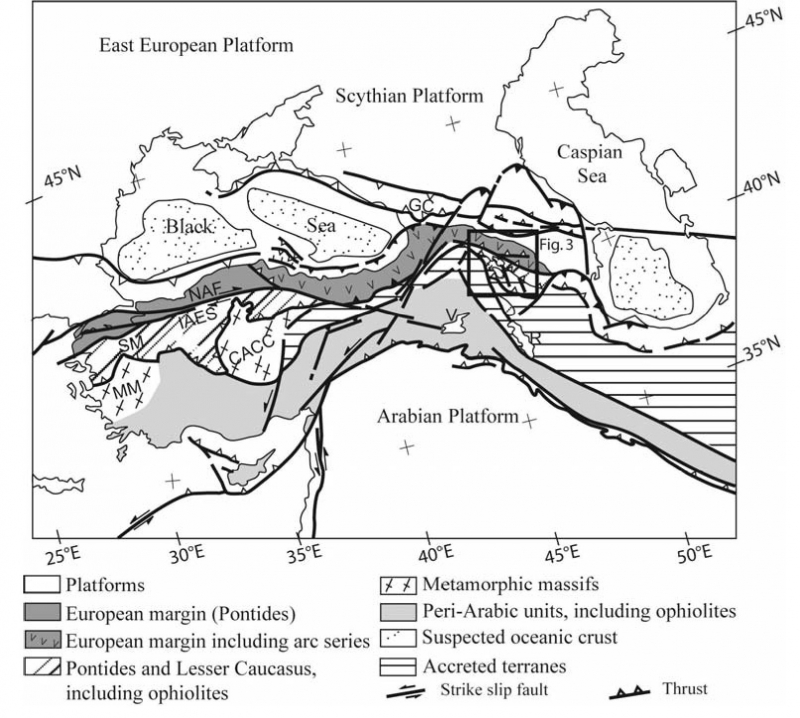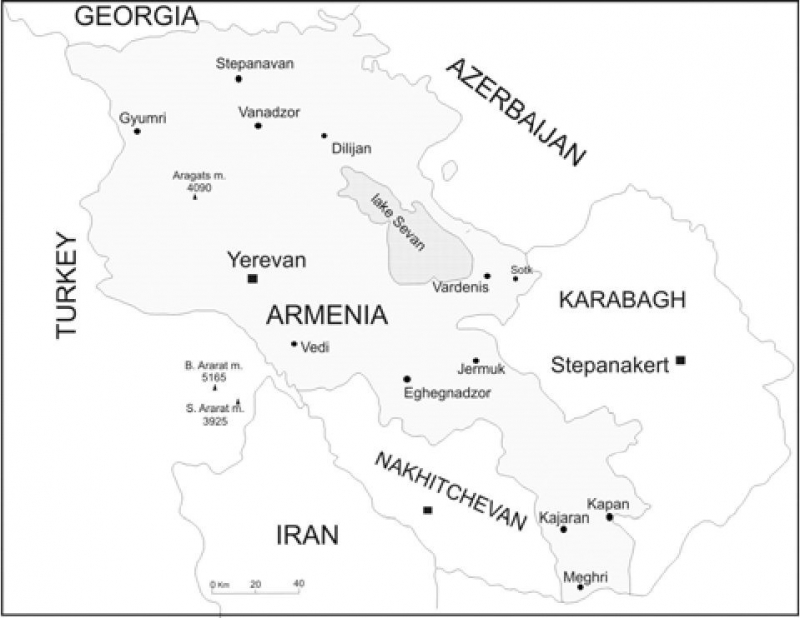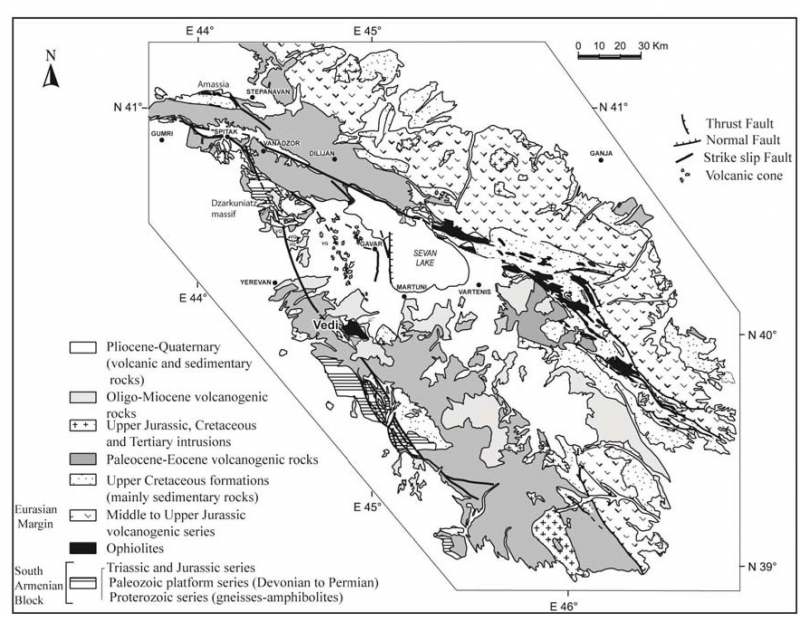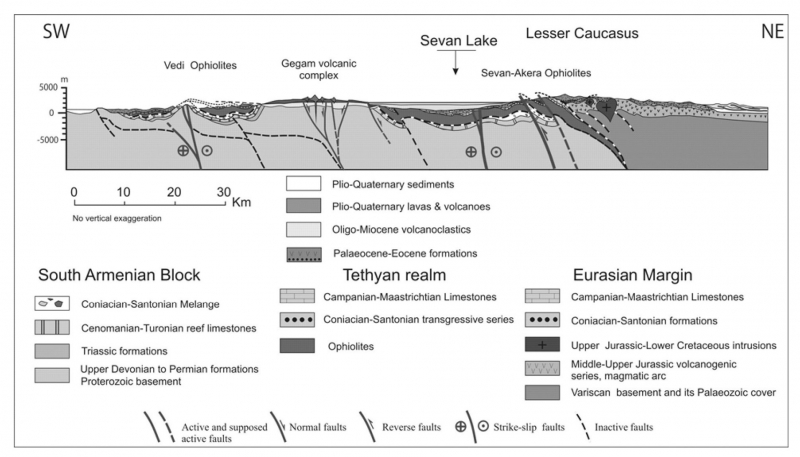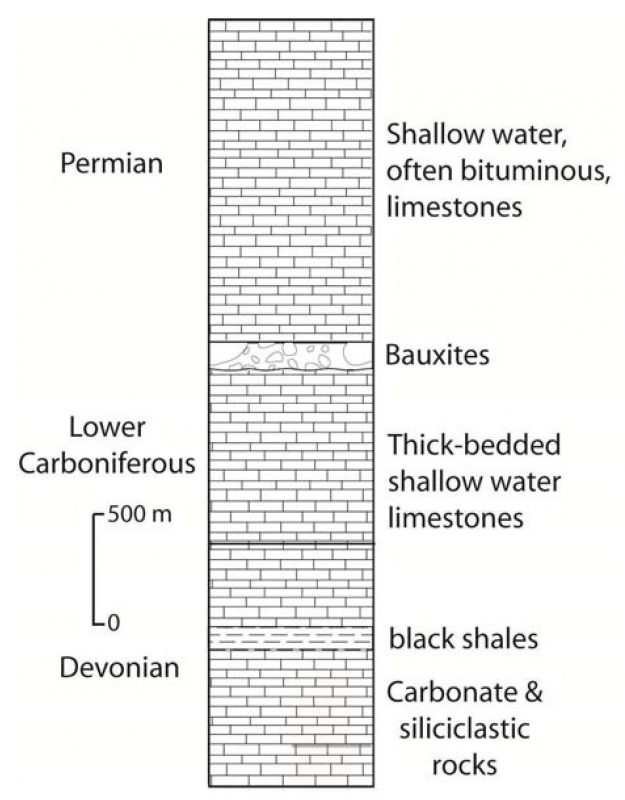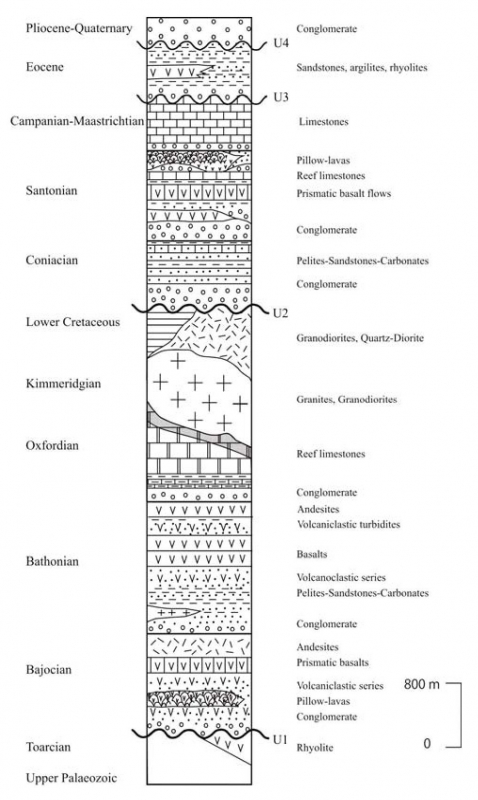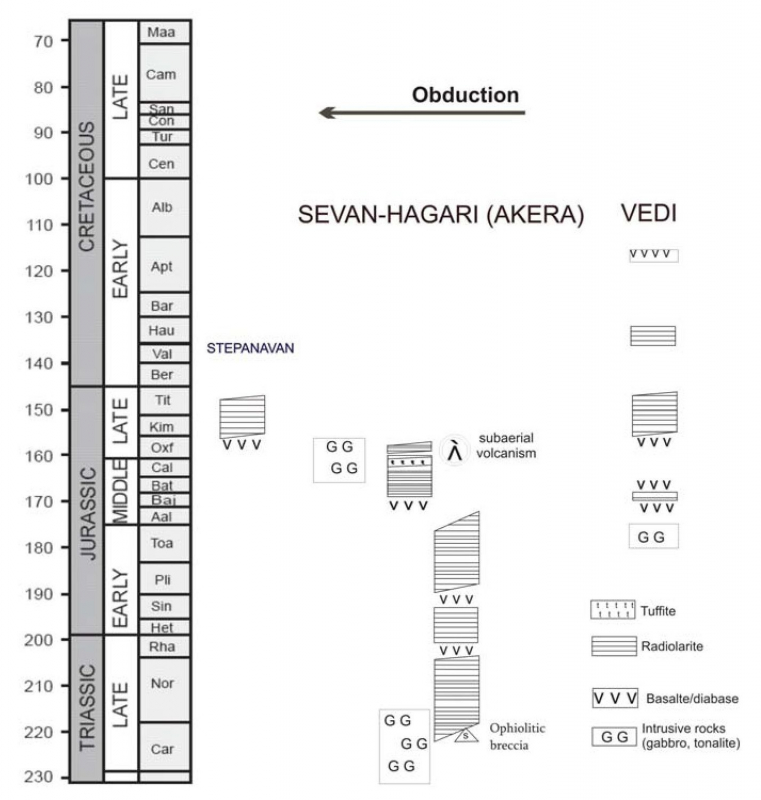I. — Introduction
The Lesser Caucasus is a mountainous area formed to a large extent by a segment of the Alpine-Himalayan mountain belt (Fig. 1). Large parts of this belt are situated in Armenia (Fig. 2), a country that displays a rich geological diversity of essentially volcanic and sedimentary rocks and a wide array of tectonic structures. Pierre Bonnet is to our knowledge the first French geologist to have worked in Armenia. He started working in the area early in the 20th century (Bonnet, 1910); he published a great number of papers and summarized his work, in a joint study with his wife, just after the 2nd world war (Bonnet, 1947). It is worth noting that the first mention of ophiolites in Vedi area is thanks to Bonnet P. & N. (19331937). The elaboration of palaeogeographic reconstructions for the “Tethys program”, developed during the 1980s, gave the opportunity to French geologists (J. Dercourt, L.-E. Ricou) to visit the Armenian ophiolites (Fig. 3) and to integrate the Tethyan evolution of the Lesser Caucasus in a much wider palaeogeographic and geodynamic framework (Dercourt et al., 1986). The disastrous earthquake of 1988 generated a renewed interest for the active tectonics of the country, situated in the junction of the Arabian Peninsula, the Iranian plate and the Taurides (Fig. 1) (Philip et al., 2001; Karakhanian et al., 2004; Avagyan et al., 2005, 2010).
Figure 1
Structural sketch map of the Taurides, Caucasus and Iranian belts (after Avagyan et al., 2005 and Sosson et al., 2010, modified). CACC: Central Anatolian Crystalline Complex, MM: Menders Massif, SM: Sakarya Massif, IAES: Izmir-Ankara-Erzinçan suture, NAF: North Anatolian Fault, GC: Great Caucasus, V: Van Lake, R: Rezaiyeh Lake.
Carte structurale simplifiée des Taurides, des chaînes iraniennes et du Caucase (d'après Avagyan et al., 2005 et Sosson et al., 2010, modifié).
Interest for improved palinspastic and palaeogeographic reconstructions of the Lesser Caucasus was renewed with the MEBE program (Middle East Basin Evolution). This is indeed one of the key areas of the Alpine-Himalayan mountain belt, since it is situated at the junction of suture zones between Turkey and Iran. Both French and Armenian teams agreed on the key importance of ophiolites to understand the geodynamic evolution of the Alpine mountain chain preserved in Armenia (Fig. 3 and 4). The numerous fieldtrips conducted since 2003, and subsequent extensive laboratory analyses, focused essentially on the age and geodynamic significance of the volcanic-plutonic rocks and radiolarites in ophiolitic sequences. More recently, the DARIUS program allowed to obtain in-depth knowledge of these subjects and to be interested in the lateral continuity of the Armenian ophiolites in Turkey (to the west) and in Iran (to the south-east).
Figure 2
Geographic map of Armenia and Karabagh and neigbouring countries.
Carte géographique d'Arménie et du Karabagh et des pays avoisinants.
Below we will outline the geological framework and geodynamic evolution of the Lesser Caucasus, stressing on the recent progress made following French-Armenian collaborative projects.
II. — Outline of the Tethyan Oceanic Realm and its Margins
The ophiolites that occur in the Lesser Caucasus are part of a Tethyan suture zone (Knipper, 1975; Adamia et al., 1981; Zakariadze et al., 1983; Knipper et al., 1986; Dercourt et al., 1986; Sosson et al., 2010). They represent the relics of an oceanic realm between Eurasia and a Gondwanan microcontinent, known as the South Armenian Block (SAB; Fig. 3 and 4). In the following paragraphs we will introduce briefly the lithological characteristics and stratigraphy of these three main tectono-stratigraphic units.
1) The South Armenian Block (SAB)
This micro-continent was detached from Gondwana during the Late Palaeozoic-Early Mesozoic. Middle Palaeozoic to Lower Triassic sequences, localized essentially in the southwestern part of Armenia and in Nakhitchevan (Fig. 2 and 3), overlie unconformably the Neo-Proterozoic crystalline basement of the SAB (i.e. the ca. 620 Ma old Dzarkuniatz massif, situated North of Yerevan, Fig. 3; Aghamalyan, 1978, 1998; Belov & Sokolov, 1973). Palaeogeographic reconstructions, based essentially on the type of sedimentary formations and on palaeomagnetic data, argue for a Gondwanan origin and suggest that the Middle Jurassic position of the SAB was situated ca. 2000 km south of its present position (Bazhenov et al., 1996). The South Armenian Block (SAB) is best known from its several thousand meters thick Palaeozoic sedimentary sequences (Fig. 5). The Middle and Upper Devonian series are mainly composed of rather shallow water limestones, rich in brachiopods, crinoids and other bioclasts, which also contain some terrigenous levels (sandstones, siltstones and argillites), as well as some black shales in the Upper Devonian (Frasnian-Famennian) interval. They are overlain by Lower Carboniferous (Tournaisian) shallow water limestones. Lenticular bauxite deposits, which may be up to 70 m-thick in places, are situated between the Tournaisian limestones and the overlying upper Permian carbonates. These are composed of thick-bedded, shallow water, often bituminous limestones that are overlain conformably by Lower Triassic limestones and argillites (Grigoryan, 1990), followed upwards by thick upper Triassic siliciclastic sequences. Jurassic rocks are known from a limited area in Armenia, 20 km to the south of Eghegnadzor town (Fig. 2), where upper Bajocian siltstones grade into Bathonian sandstones (Aslanyan, 1958). According to Mandalyan (1990) the siltstones are Bathonian in age and they are overlain by Callovian limestones. Jurassic sequences are much better known in Nakhitchevan and in Iran where a 500 m-thick Lower and Middle Jurassic sedimentary sequence overlies Upper Triassic strata (Lordkipanidze et al., 1988). Thick-bedded Cenomanian - Turonian reefal carbonates overlie disconformably the entire sequence (Hakobyan, 1978). An upper Cenomanian flysch, followed conformably by an upper Coniacian – Santonian olistostrome, caps the entire sedimentary sequence (Sokolov, 1977; Sosson et al., 2010).
2) The Eurasian margin
Some Upper Palaeozoic (Carboniferous) volcaniclastic sequences are known to lie unconformably over the Variscan metamorphic basement of the Eurasian margin preserved in the Lesser Caucasus (Adamia et al., 1983). The ca. 300 Ma old Variscan metamorphic massifs in NE Armenia and their counterparts in Georgia form the basement of the Mesozoic volcano-sedimentary sequences of the Eurasian margin (see Sosson et al., 2010 for a review). The bulk of these sequences (discussed below) are of Middle-Late Jurassic and Late Cretaceous age; they attest to the likely presence of a subduction-related volcanic arc in relation to the subduction of Tethyan oceanic lithosphere under the active Eurasian margin.
A first major transgressive event took place during the Bajocian on the Eurasian margin of the Lesser Caucasus, as this is suggested by the widespread accumulation of basal conglomerates overlying unconformably relics of Variscan basement (Fig. 6). They are followed upwards by a ca. 2,400 m-thick Bajocian-Bathonian volcano-sedimentary sequence, composed of volcaniclastic sediments, sandstones and marls with ammonites, but also basalts and andesites that reflect a major magmatic event that took place during the Middle Jurassic (Maghakyan et al., 1985; Lordkipanidze et al., 1988). A younger transgressive event occurred during the Oxfordian as this is recorded by a basal conglomerate followed upwards by siltstones, mudstones and reefal limestones. Massive plutonic intrusions (i.e. granodiorites, Melkonyan, 1976) occurred during the Kimmeridgian, with as a result the genesis of many ore-deposits (i.e. copper and barite, gold-bearing porphyry copper deposits, Melkonyan & Akopyan, 2006). Lower Cretaceous sedimentary sequences are much reduced in thickness. They are overlain by a third important transgressive sequence of Coniacian age, composed of red conglomerates and followed upwards by sandstones and reef limestones. Identical sedimentary facies accumulated during the Santonian; they include prismatic basalt flows. They are overlain by pillow and massive lava flows, which record the ongoing magmatic activity on the Eurasian margin. The thin-bedded pelagic limestones (including some calciturbidites) that accumulated during the Campanian – Maastrichtian are devoid of any intercalated lavas flows and they therefore attest of the end of the magmatic activity on the Eurasian margin of the Lesser Caucasus.
3) The ophiolitic units
Several outcrops of ophiolitic sequences occur in the Lesser Caucasus. They are organised in two main zones (Fig. 3):
- The Sevan-Hagari (Akera) suture zone, in which we can also include the Amassia-Stepanavan ophiolites,
- The Vedi ophiolite, which crops out in the Khosrov Natural resort and is situated in the south-east of the capital city Yerevan.
It is likely that the Armenian ophiolites extend westwards into Turkey and can be thus correlated with the Izmir-Ankara-Erzinçan suture zone. However, their extension towards the south and possible relation with the Khoy ophiolite in Iran are still poorly understood.
Figure 3
Schematic geological map of the Lesser Caucasus (after Sosson et al., 2010, modified).
Carte géologique schématique du Petit Caucase (d'après Sosson et al., 2010, modifié).
a) The Amassia-Stepanavan-Sevan-Hagari ophiolitic zone
This is a NW-SE oriented zone that comprises ophiolites cropping out at the east and SE of Lake Sevan (Palanjian, 1971; Knipper, 1975; Knipper & Khain, 1980; Abovyan, 1981; Aslanyan & Satian, 1977; Galoyan et al., 2009), as well as the Amassia-Stepanavan ophiolite units that crop out in the north-western part of the country (Sokolov, 1974; Galoyan et al., 2007; Galoyan, 2008; Sosson et al., 2010). The outcrops of the Amassia-Stepanavan-Sevan-Hagari zone extend therefore for ca. 400 Km, from NW Armenia to Karabagh passing through the east of Lake Sevan. They represent the Tethys ocean suture zone in the Lesser Caucasus (Fig. 4), which was formed as a result of collision between the South Armenian Block and Eurasia (Sosson et al., 2010).
Petrographic observations establish that the magmatic rocks of the Sevan ophiolite display a high level of fractional crystallization (Galoyan, 2008; Galoyan et al., 2009); they include olivine and pyroxene gabbros and are intruded and overlain by amphibole-bearing gabbros and diorites that are associated to plagiogranites. Peridotites, although common, are in general highly serpentinized following submarine hydrothermal alteration. Galoyan et al. (2009) and Rolland et al. (2009) consider this serpentinization as the result of exhumation of peridotites along normal faults that were active in the context of an intraoceanic extensional regime. Based on the total petrological, stratigraphic and structural evidence and because pillow lavas and doleritic dykes are relatively rare, the aforementioned authors suggested that the Sevan-Hagari ophiolite can be considered as being formed in a slow-spreading ridge setting.
Radiometric ages are scarse for the igneous parts of the Sevan-Hagari ophiolite (Fig. 7). Zakariadze et al. (1990) obtained a 160±4 Ma age (Callovian-Oxfordian, according to the time scale of Gradstein et al. 2004) following application of the U-Pb method on zircons from tonalite, while Bogdanovski et al. (1992) dated norites and gabbro-norites in Karabagh as 224±8 and 226±13 Ma in age, respectively (Late Ladinian to Carnian), by using the Sm-Nd method. More recently, Galoyan et al. (2009) obtained a 165.3±1.7 Ma plateau age (Bathonian – early Callovian), by applying the 40Ar/39Ar method on amphiboles extracted from a gabbro. Finally, Rolland et al. (2009) dated radiometrically (Ar/Ar) some Aptian lavas (117.3±0.9 Ma) in the Vedi area.
Radiolarian biochronology has become invaluable the last twenty-five years for elucidating the complex geodynamic evolution of Tethyan oceanic basins, since Radiolaria are commonly the only fossils able to date the sedimentary cover of ophiolites. Early radiolarian studies conducted on the sedimentary cover of Armenian ophiolites suggested a poorly constrained Late Jurassic-Neocomian time interval for radiolarites intercalated or overlying ophiolitic lavas from the Sevan ophiolitic zone (Zakariadze et al., 1983). Later studies (Vishnevskaya, 1995, 2001) benefited from modern and better elaborated biozonations (i.e. Baumgartner et al., 1995), which allowed the discovery in Karabagh of Bajocian-lower Bathonian cherts overlying basaltic lavas. At an outcrop near the Armenian/Karabagh border (Old Sotk pass, Fig. 2), Knipper et al. (1997) extracted late Carnian and Toarcian Radiolaria from siliceous pelites and cherts intercalated with basalts and basaltic andesites. Because this Upper Triassic to Lower Jurassic volcano-sedimentary sequence overlies (although with a minor faulted contact) sedimentary breccia with fragments of predominantly gabbroic or diabasic composition, the above authors considered that the plutonic part of the Sevan-Hagari ophiolite is Late Carnian or older in age.
Figure 4
Schematic geological cross-section across Armenia (after Sosson et al., 2010 and Avagyan et al., 2010, modified).
Coupe géologique schématique à travers l'Arménie (d'après Sosson et al., 2010 et Avagyan et al., 2010, modifié).
Recently, Asatryan et al. (2010) provided new biostratigraphic data for the sedimentary cover of the Sevan ophiolite. More particularly, they established that the oldest radiolarites overlying ophiolitic lavas east of Lake Sevan are late Bajocian to Bathonian in age and that the upper Bathonian to lower Oxfordian radiolarites are intercalated with tuffites, suggestive of subaerial volcanic activity.
In the Stepanavan area (NW Armenia), Galoyan et al. (2007) described the ophiolitic sequence as characterized by extensive serpentinites, as well as gabbros, gabbro-norites and plagiogranites; the whole sequence is overlain by pillow lavas and radiolarites which were dated as Late Jurassic by Danelian et al. (2007)
Figure 5
Generalized stratigraphy of the Palaeozoic sedimentary sequences of the South Armenian block.
Lithostratigraphie simplifiée des séries sédimentaires paléozoïques du bloc Sud Arménien.
b) The Vedi ophiolite
Situated to the south-east of the capital city Yerevan, the Vedi ophiolite is also composed of serpentinites, gabbros and a thick pile of massive and pillowed lava flows (Knipper & Sokolov, 1976; Aslanyan & Satian, 1977; Sokolov, 1977; Knipper & Khain, 1980; Galoyan, 2008; Rolland et al., 2009). For some authors the Vedi ophiolite is considered to have been formed in a small separate oceanic basin (Satian, 1979, 2005), for others it corresponds to an allochthonous unit (a folded klippe sequence) which was formed in the same oceanic realm as the Sevan-Akera ophiolites (Knipper & Sokolov, 1976; Sokolov, 1977; Galoyan, 2008; Sosson et al., 2010).
Biostratigraphic data for the sedimentary cover of the Vedi ophiolite were published previously by Belov et al. (1991) and the ages obtained from the mentioned radiolarian assemblages were revised by Danelian et al. (2010). The data establish the accumulation of radiolarites during three distinct intervals of the Middle Jurassic to Early Cretaceous; however, their relationship with lavas is unclear.
Danelian et al. (2008) and Asatryan (2009) discovered Bajocian Radiolaria in radiolarites intercalated with lavas, while Danelian et al. (2010) established recently the occurrence of Upper Jurassic radiolarites stratigraphically overlying basaltic lavas. In addition, Rolland et al. (2010) provided a radiometric dating for an amphibole of a diorite with the 40Ar/39Ar method and found a 178.7±2.6 Ma plateau age (Toarcian).
III. — Geological Evolution of the Lesser Caucasus with Special Focus on its Tethyan History
1) Evolution of the Tethyan oceanic realm in the Lesser Caucasus
Current evidence suggests that oceanic spreading in the Armenian territory was initiated sometime during the Middle to Late Triassic (Fig. 7). Evidence is based on both a Late Triassic radiometric dating of gabbroids from Karabagh (Bogdanovski et al., 1992) and the Carnian palaeontological (radiolarian) age obtained by Knipper et al. (1997), for siliceous pelites that crop out at the Old Sotk pass locality (Fig. 2); according to Knipper et al. (1997) the pelites lie stratigraphically over breccia composed of mafic intrusive rock fragments (gabbroic and diabasic fragments).
It is interesting to note that the radiometrically dated gabbros are either Triassic or Jurassic in age (Bathonian to Oxfordian for the Sevan ophiolite, Toarcian in Vedi). It is also worth noting that with the exception of the Upper Triassic - Lower Jurassic volcano-sedimentary sequence studied by Knipper et al. (1997) all the other dated sequences of radiolarites and intercalated lavas range between the Middle Jurassic and the Lower Cretaceous.
The geochemical affinity (contaminated MORB to calc-alkaline) of basaltic lavas situated above the intrusive lithologies suggested to Galoyan et al. (2007, 2009) and Rolland et al. (2009) that the bulk of the Armenian ophiolites represent oceanic lithosphere that was formed behind an intra-oceanic subduction zone, in a marginal slow-spreading back-arc basin that opened during the Middle Jurassic. This was concluded on the basis of the biostratigraphic evidence that was available at the time, in combination with petrological and geochemical arguments from the Sevan ophiolite. Indeed, the oldest radiolarian ages obtained from three different areas (Vedi : Danelian et al., 2008, Asatryan 2009; Sevan : Asatryan et al., 2010; and Karabagh : Vishnevskaya, 1995) argue for early Middle Jurassic radiolarite accumulation associated with lavas.
Figure 6
Generalized lithostratigraphy of the Eurasian margin in the Lesser Caucasus (after Sosson et al., 2010, modified).
Lithostratigraphie simplifiée de la marge eurasienne dans le Petit Caucase (d'après Sosson et al., 2010, modifié).
The radiometric ages available on tonalites (160±4 Ma; Zakariadze et al., 1990) and gabbros (165.3±1.7 Ma; Galoyan et al., 2009) of the Sevan ophiolite suggest that oceanic lithosphere formation continued during the Bathonian-Callovian, and probably the Oxfordian as well. These radiometric ages on the intrusive part of the Sevan ophiolite are in good agreement with the middle/upper Oxfordian to upper Kimmeridgian/lower Tithonian radiolarites that accumulated above lavas of the Vedi ophiolite (Danelian et al., 2010). In addition, the Bathonian to lower Oxfordian tuffites dated recently at Sarinar may be regarded as the sedimentary output of intra-oceanic arc volcanism that was active in the Tethyan oceanic realm preserved in Armenia (Asatryan et al., 2010).
Figure 7
Synthesis of available palaeontological and radiochronological ages for the ophiolitic sequences and their sedimentary cover in the Lesser Caucasus.
Synthèse des âges paléontologiques et radiochronologiques disponibles sur les séries ophiolitiques et leur couverture sédimentaire dans le Petit Caucase.
According to Galoyan et al. (2009), Rolland et al. (2009, 2010) and Sosson et al. (2010), the geochemistry of basaltic lavas suggests also the presence of a second distinct extrusive system, characterized by an alkaline OIB series of lavas that can be considered to be the expression of a mantle plume event. Indeed, early geochemical studies by Zakariadze et al. (1983) had revealed the presence of alkaline lavas in the Armenian ophiolites. However, it is thanks to more recent studies by Galoyan et al. (2009) and Rolland et al. (2009) that the presence of lavas related to a hot spot activity (OIB type affinity) above the ophiolite was established. Rolland et al. (2009) dated radiometrically (Ar/Ar) one of these lavas as 117.3±0.9 Ma in age (Vedi area) and argued that the Aptian emplacement of the oceanic plateau on Middle-Late Jurassic oceanic crust could have facilitated the process of obduction of the Armenian ophiolites during the Coniacian. Finally, a third pile of lavas of calc-alkaline affinity lies over the previous magmatic sequences (Zakariadze et al., 1983; Galoyan et al., 2007; Galoyan, 2008).
2) Closure of the Tethyan oceanic realm in the Lesser Caucasus
The Tethyan oceanic lithosphere preserved in the Lesser Caucasus was obducted on the South Armenian Block during the Late Cretaceous (Knipper, 1975; Sokolov, 1977; Knipper & Khain, 1980).
One key locality that best records this early closing phase and obduction of ophiolites is preserved in Vedi (Fig. 3), where current evidence suggests that the obduction of ophiolites took place during the Late Coniacian – Santonian. The structural and biostratigraphic constraints of this important geodynamic event were detailed in Sosson et al. (2010). Close to the entry of the natural reserve exists a remarquable outcrop of thick-bedded Cenomanian limestones of the South Armenian Block overlain by a flysch sequence; the latter is followed in turn stratigraphically by an olistostrome, of upper Coniacian-Santonian age, that contains reworked ophiolitic rocks as olistoliths. The sequence is finally overthrust by the Vedi ophiolite.
Not far from this outcrop the ophiolite is overlain by an upper Coniacian-Santonian reef constructed essentially by rudists. These key outcrops establish that the obduction took place during the late Coniacian-Santonian (Sosson et al., 2010)
Following the obduction of ophiolites, sometime during the late Coniacian-Santonian, the sea covered most of the Lesser Caucasus. During this time interval the Vedi area was part of a relatively shallow-water environment in which were developed reefs constructed essentially by rudists. Further to the north-east, in the Sevan suture zone, the ophiolites were covered by pelagic limestones which accumulated in deeper waters.
During the Campanian-Maastrichtian the Vedi area was probably further uplifted and submitted to erosion, since only rare sedimentary rocks of this age are found in the area. On the contrary the Sevan suture zone remained under an open marine environment in which accumulated thin-bedded limestones with Globotruncana and inoceramid bivalves.
It is worth noting that this time interval corresponds to a period devoid of any magmatic activity in this domain.
3) Main collision stages and recent tectonic-volcanic activity
Evidence for a Late Cretaceous collision triggering age between the SAB and Eurasia was obtained on metamorphic rocks from Stepanavan (Sevan-Hagari suture zone, Rolland et al., 2009), but the main collision stage ranges in age between the Palaeocene and the Middle Eocene (Galoyan 2008, Sosson et al., 2010).
According to Sosson et al. (2010) it is likely that Tethyan oceanic lithosphere was all consumed by the Palaeocene in the subduction zone of the Eurasian margin (which corresponds to the Sevan-Hagari suture zone) and that the South Armenian Block had entered into collision by then. This first collision stage had as a consequence: 1) the uplift and erosion of the Sevan-Hagari ophiolites within the suture zone, and 2) the development of a flexural basin at the front of the collision zone. Indeed, ca. 1000 meters of erosional products accumulated during the Palaeocene in a foreland molassic basin situated in the southern part of Armenia; at the same time the Sevan-Hagari suture zone was being affected by deformation, uplift and erosion (Sosson et al., 2010).
A major transgressive event took place during the late Middle and Late Eocene and it was followed closely by extensive volcanic activity in the entire area; a ca. 100 m-thick sequence of sandstones and Nummulitic limestones accumulated unconformably above all the three tectono-sedimentary units: the Eurasian margin, the ophiolite nappe/suture zone and the SAB.
A fundamental change in deformation style occurred during the Miocene, when in an overall north–south compression field, the secondary orientation changed from NW–SE to NE–SW (Avagyan et al., 2010). At this time the Great Caucasus and the Armenian Highland were situated in the central part of the continental collision; they display a dense active fault network of various strikes and kinematics. GPS data point to strain rates in the order of 10 mm/year across this region (Reilinger et al., 2006).
Since continental collision, volcanic activity was characterized by both basaltic and rhyolitic lavas (Karapetian et al., 2001). In Armenia two stages of intracontinental volcanism are identified: the first one took place during the Oligocene to Early Miocene and the second one from Late Miocene to Quaternary, when volcanic massifs and cones were formed in most of the Armenian Highland (Karapetian et al., 2001) exceeding in places 1 km in thickness and ranging in age between 11 Ma and the present (Keskin 2003). The most recent volcanic activity of the Holocene times comprises the volcanism of Sunik, Vardenis and Gegam massifs in Armenia (e.g. Karakhanian et al., 2002; 2003), and in Nemrout, Sipan, underwater volcanoes of Van lake, Tondourek and Ararat volcanoes in Eastern Turkey (e.g. Karakhanian et al., 2002).
In Armenia the tectonic stress regime is mainly strike-slip, with both transtensional and transpressional characteristics. As previously established by Philip et al. (1989), Karakhanian and Balasanian (1992), Karakhanian et al. (2004) and Avagyan et al. (2005), four major coeval types of neotectonic faults are present, including: (1) NE trending sinistral strike–slip faults; (2) NW trending dextral strike–slip faults; (3) east-trending thrusts; and (4) north-trending normal faults. The most important of these structures corresponds to the Sevan–Hagari suture zone.
Strong palaeoearthquakes are up to M7.5 in magnitude; they are associated with faults which may reach 350–500 km in length and experience slip rates varying between 0.5 and 4 mm/year (Trifonov et al., 1994; Philip et al., 2001; Karakhanian et al., 2004). Recent manifestations of destructive seismic activity in the region include the 1976 (M= 7.1) Chalderan, 1983 (M= 6.8) Norman, 1988 (M= 7.0) Spitak, 1991 (M=7.0) Racha, 1990 (M= 7.3) Roudbar-Manjil and 2011 Van (M=7.2) earthquakes which were associated with high levels of hazard and risk.
IV. — Conclusions
Understanding the time frame of formation and geodynamic significance of ophiolites preserved in the Lesser Caucasus is of key significance to reconstruct the evolution of the Tethyan oceanic branch preserved in this part of the Alpine-Himalayan mountain belt. While the extension of Caucasian ophiolites into the Izmir-Ankara-Erzinçan suture zone of Turkey is a realistic possibility, their extension into Iran remains a big puzzle awaiting further detailed work to be resolved. Understanding the geological evolution of a number of key ophiolitic units will help lateral correlations and will provide important constraints for the development of improved palaeogeographic reconstructions.
Thanks to the constructive French-Armenian collaboration, major progress was achieved these last eight years on the understanding of the geological history and geodynamic significance of Armenian ophiolites. We paid special attention to the dating of sedimentary rocks that are in stratigraphic contact with lavas, in order to constrain events of submarine volcanic activity. New field and laboratory (micropalaeontological and petrographic) work, combined with geochemical analyses obtained on lavas, improved greatly our understanding of the geodynamic evolution in the Lesser Caucasus.
Acknowledgments. — Funding from the MEBE and the DARIUS programs, the French Ministry of Foreign Affairs (ECO-NET program) and the Embassy of France in Armenia (PhD grants to G. Galoyan and G. Asatryan and post-doctoral grant to L. Sahakyan) is gratefully acknowledged. The fieldwork was facilitated by the support of the Institute of Geological Sciences (Academy of Science of Armenia). Constructive remarks by J. Charvet (Univ. Orléans) and O. Averbuch (Univ. Lille 1) improved the manuscript.

